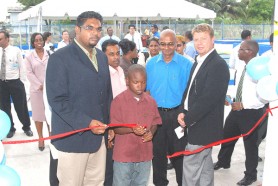-to serve 4,000 residents
The Ministry of Housing and Water with the Guyana Water Incorporated (GWI) yesterday commissioned the rehabilitated Tucville Sewerage Receiving Station at Arapima Street, Tucville. The $83M station, which was funded by the Inter American Development Bank (IDB), is expected to serve an approximate population of 4,000 residents and links the Tucville facility to the Georgetown sewerage system.

The old system was constructed in 1970 and comprised a collection of gravity sewers that drained directly to the facility. However it went into a state of disrepair, causing overflows of sewerage on the roadways and drainage canals posing serious health risks.
In his remarks before the cutting of the ribbon to mark the commissioning, Housing Minister Irfaan Ali said, “We are not here in celebration but in the memory of a little five year old girl, of what was described by the media as ‘an abandoned sewage site.’” The minister added, “We’re here in recognition of that little girl who paid the ultimate price of a facility that did not” live up to its expectations.
Ali also pointed out that the new station is “an investment that has been developed with safety in mind and environment in mind” while at the same time emphasizing that “people and residents need to understand we have to develop a new culture on the way we look at our environment.”
On July 17, 2006, a five-year-old girl, Briana Dover, became stuck in the Tucville cesspool and drowned despite the heroic efforts of a nearby resident, Orduck Reid. The GWI had announced some days later that it would rehabilitate the structure and reopen it for use by private waste disposal companies and to serve some 800 homes.
Meanwhile, country representative of the IDB Marco Nicola said that it was his “great pleasure” to be a part of the opening and noted that the ultimate goal was the improvement of the quality of life. He also pointed out the Bank’s commitment to work with Guyana and encouraged that there be no more illegal dumping of waste and that its disposal be done in compliance with the regulations set out.
The new sewerage system will collect sewage from septic tanks operated by the private sector as part of GWI’s private-public partnership, while promoting proper hygiene practices and reducing water borne diseases in the communities. The sludge collected by tanker operators will be disposed of at the new facility and together with the sewage from the Tucville community will be pumped through a 200mm sewer line that was also recently constructed to link the Tucville facility to the Georgetown sewerage system at the junction of Brickdam and Winter Place. The operation of the system is facilitated by two submersible pumps which can either work manually or automatically. One pump will be on work duty and the other will be on standby. The system is equipped with four automatic sensors, three of which will act as a start/stop switch and the fourth as a high level alarm. The station consists of a complex of three main structures which include a pump house, sewage receiving chambers and operator’s hut.




